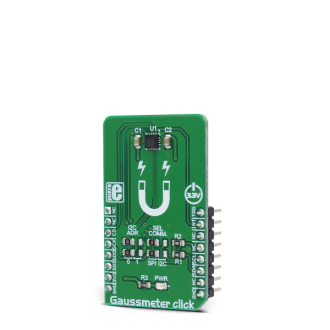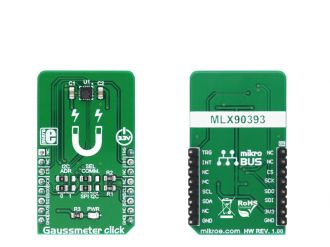
We strongly encourage users to use Package manager for sharing their code on Libstock website, because it boosts your efficiency and leaves the end user with no room for error. [more info]

Rating:
Author: MIKROE
Last Updated: 2018-07-18
Package Version: 1.0.0.0
mikroSDK Library: 1.0.0.0
Category: Magnetic
Downloaded: 5792 times
Not followed.
License: MIT license
Gaussmeter click is a device that is used for measuring the magnetic field in X, Y and Z axes. This Click board features the MLX90393, a micropower magnetometer based on the proprietary Triaxis technology, from Melexis. It can detect the magnetic field down to 0.8 µT (8 mG) thanks to this technology.
Do you want to subscribe in order to receive notifications regarding "Gaussmeter click" changes.
Do you want to unsubscribe in order to stop receiving notifications regarding "Gaussmeter click" changes.
Do you want to report abuse regarding "Gaussmeter click".


Library Description
Library initializes and defines I2C and SPI driver and has the ability to write to registers and read from registers by both driver communication. Library also performs magnetic field measurement via x, y and/or z-axis and converts results to µT. The library can measure 16-bit temperature value. For more details check the documentation.
Key functions
void gaussmeter_enableMeasure( uint8_t zAxis, uint8_t yAxis, uint8_t xAxis, uint8_t temp ) - Function determines which axis will be included in the measurement.
uint8_t gaussmeter_sendCommand( uint8_t command_ ) - Function performs desired command.
uint8_t gaussmeter_readReg( uint8_t register_address, uint16_t *dataOut ) - Function reads 16-bit data from a register.
uint8_t gaussmeter_writeReg( uint8_t register_address, uint16_t transfer_data ) - Function writes 16-bit data in a register.
uint8_t gaussmeter_getData( uint32_t *dataOut ) - Function gets selected measured data.
Examples Description
The application is composed of three sections :
System Initialization - Initializes peripherals and pins.
Application Initialization - Initializes I2C or SPI driver and performs click configuration.
The device is configured to work in Wake Up On Change mode.
Application Task - (code snippet) - Gets x, y and z-axis measured data (without temperature) in µT.
Logs the desired results on USBUART and repeats measurements every 400ms.
void applicationTask()
{
errorBit = gaussmeter_getData( &bufferData[ 0 ] );
if (!errorBit)
{
axisCheck = 1;
indx = 0;
for (counter = 0; counter < 4; counter++)
{
switch (commandByteLow & axisCheck)
{
case 1 :
{
mikrobus_logWrite( "16-bit temperature value is: ", _LOG_TEXT );
LongWordToStr( bufferData[ indx ], text );
mikrobus_logWrite( text, _LOG_LINE );
indx++;
break;
}
case 2 :
{
mikrobus_logWrite( "X axis is: ", _LOG_TEXT );
LongWordToStr( bufferData[ indx ], text );
mikrobus_logWrite( text, _LOG_TEXT );
mikrobus_logWrite( "microT", _LOG_LINE );
indx++;
break;
}
case 4 :
{
mikrobus_logWrite( "Y axis is: ", _LOG_TEXT );
LongWordToStr( bufferData[ indx ], text );
mikrobus_logWrite( text, _LOG_TEXT );
mikrobus_logWrite( "microT", _LOG_LINE );
indx++;
break;
}
case 8 :
{
mikrobus_logWrite( "Z axis is: ", _LOG_TEXT );
LongWordToStr( bufferData[ indx ], text );
mikrobus_logWrite( text, _LOG_TEXT );
mikrobus_logWrite( "microT", _LOG_LINE );
indx++;
break;
}
default :
{
break;
}
}
axisCheck <<= 1;
}
mikrobus_logWrite( "", _LOG_LINE );
Delay_ms( 400 );
}
}
Other mikroE Libraries used in the example:
Additional notes and information
Depending on the development board you are using, you may need USB UART click, USB UART 2 click or RS232 click to connect to your PC, for development systems with no UART to USB interface available on the board. The terminal available in all MikroElektronika compilers, or any other terminal application of your choice, can be used to read the message.